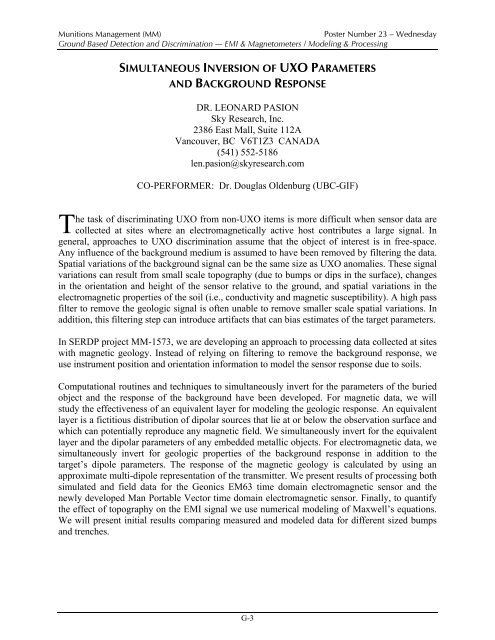Wednesday (Group 2) - SERDP-ESTCP - Strategic Environmental ...
Wednesday (Group 2) - SERDP-ESTCP - Strategic Environmental ...
Wednesday (Group 2) - SERDP-ESTCP - Strategic Environmental ...
You also want an ePaper? Increase the reach of your titles
YUMPU automatically turns print PDFs into web optimized ePapers that Google loves.
Munitions Management (MM)<br />
Poster Number 23 – <strong>Wednesday</strong><br />
Ground Based Detection and Discrimination — EMI & Magnetometers / Modeling & Processing<br />
T<br />
SIMULTANEOUS INVERSION OF UXO PARAMETERS<br />
AND BACKGROUND RESPONSE<br />
DR. LEONARD PASION<br />
Sky Research, Inc.<br />
2386 East Mall, Suite 112A<br />
Vancouver, BC V6T1Z3 CANADA<br />
(541) 552-5186<br />
len.pasion@skyresearch.com<br />
CO-PERFORMER: Dr. Douglas Oldenburg (UBC-GIF)<br />
he task of discriminating UXO from non-UXO items is more difficult when sensor data are<br />
collected at sites where an electromagnetically active host contributes a large signal. In<br />
general, approaches to UXO discrimination assume that the object of interest is in free-space.<br />
Any influence of the background medium is assumed to have been removed by filtering the data.<br />
Spatial variations of the background signal can be the same size as UXO anomalies. These signal<br />
variations can result from small scale topography (due to bumps or dips in the surface), changes<br />
in the orientation and height of the sensor relative to the ground, and spatial variations in the<br />
electromagnetic properties of the soil (i.e., conductivity and magnetic susceptibility). A high pass<br />
filter to remove the geologic signal is often unable to remove smaller scale spatial variations. In<br />
addition, this filtering step can introduce artifacts that can bias estimates of the target parameters.<br />
In <strong>SERDP</strong> project MM-1573, we are developing an approach to processing data collected at sites<br />
with magnetic geology. Instead of relying on filtering to remove the background response, we<br />
use instrument position and orientation information to model the sensor response due to soils.<br />
Computational routines and techniques to simultaneously invert for the parameters of the buried<br />
object and the response of the background have been developed. For magnetic data, we will<br />
study the effectiveness of an equivalent layer for modeling the geologic response. An equivalent<br />
layer is a fictitious distribution of dipolar sources that lie at or below the observation surface and<br />
which can potentially reproduce any magnetic field. We simultaneously invert for the equivalent<br />
layer and the dipolar parameters of any embedded metallic objects. For electromagnetic data, we<br />
simultaneously invert for geologic properties of the background response in addition to the<br />
target’s dipole parameters. The response of the magnetic geology is calculated by using an<br />
approximate multi-dipole representation of the transmitter. We present results of processing both<br />
simulated and field data for the Geonics EM63 time domain electromagnetic sensor and the<br />
newly developed Man Portable Vector time domain electromagnetic sensor. Finally, to quantify<br />
the effect of topography on the EMI signal we use numerical modeling of Maxwell’s equations.<br />
We will present initial results comparing measured and modeled data for different sized bumps<br />
and trenches.<br />
G-3

















